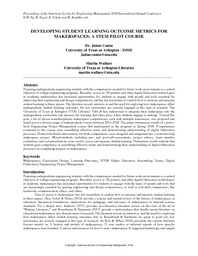
ATTENTION: The works hosted here are being migrated to a new repository that will consolidate resources, improve discoverability, and better show UTA's research impact on the global community. We will update authors as the migration progresses. Please see MavMatrix for more information.
Show simple item record
| dc.contributor.author | Cantu, Jaime | |
| dc.contributor.author | Wallace, Martin K. | |
| dc.date.accessioned | 2018-11-02T05:09:33Z | |
| dc.date.available | 2018-11-02T05:09:33Z | |
| dc.date.issued | 2018-10-19 | |
| dc.identifier.citation | Cantu, J., & Wallace, M. K. (2018, October 17-20). Developing student learning outcome metrics for makerspaces: A STEM pilot course. Paper presented at the American Society for Engineering Management 2018 International Annual Conference, Coeur d’Alene, ID. | en_US |
| dc.identifier.uri | http://hdl.handle.net/10106/27569 | |
| dc.description.abstract | Preparing undergraduate engineering students with the competencies needed for future work environments is a central objective of college engineering programs. Recently, access to 3D printers and other digital fabrication technologies in academic makerspaces has increased opportunities for students to engage with people and tools essential for improving their engineering and design competencies, and has led researchers to explore how to increase and measure student learning in these spaces. The literature reveals interests in and the need for exploring how makerspaces affect undergraduate student learning outcomes, but few universities are actively engaged in this type of research. The University of Texas at Arlington (UTA) Libraries’ FabLab has endeavored to integrate their makerspace into the undergraduate curriculum and measure the learning that takes place when students engage in making. Toward this goal, a list of eleven transdisciplinary makerspace competencies, each with multiple dimensions, was proposed and tested across a diverse range of undergraduate courses between 2016-2018. This paper summarizes results of a senior-level Engineering Project Management course that participated in the program in Spring 2018. Competencies examined in this course were assembling effective teams and demonstrating understanding of digital fabrication processes. Homework-based interventions for both competencies were designed and integrated into a semester-long makerspace project. Mixed-methods including pre- and post-self-assessments, project rubrics, team member evaluations and oral presentations were used to assess and measure student learning. Preliminary results indicate that students gain competency in assembling effective teams and demonstrating their understanding of digital fabrication processes by completing projects in makerspaces. | en_US |
| dc.description.sponsorship | Institute of Museum and Library Services (LG-97-17-0010-17) | en_US |
| dc.language.iso | en_US | en_US |
| dc.publisher | American Society for Engineering Management | en_US |
| dc.rights | Attribution-ShareAlike 3.0 United States | * |
| dc.rights.uri | http://creativecommons.org/licenses/by-sa/3.0/us/ | * |
| dc.subject | Project Management | en_US |
| dc.subject | Assembling Teams | en_US |
| dc.subject | Digital Fabrication | en_US |
| dc.subject | Makerspaces | en_US |
| dc.subject | Maker Literacies | en_US |
| dc.subject | Engineering | en_US |
| dc.subject | Curriculum | en_US |
| dc.title | Developing Student Learning Outcome Metrics for Makerspaces: A Stem Pilot Course | en_US |
| dc.type | Article | en_US |
Files in this item
- Name:
- ASEM_2018_311 Final_rev.pdf
- Size:
- 480.7Kb
- Format:
- PDF
This item appears in the following Collection(s)
Show simple item record
Except where otherwise noted, this item's license is described as Attribution-ShareAlike 3.0 United States



